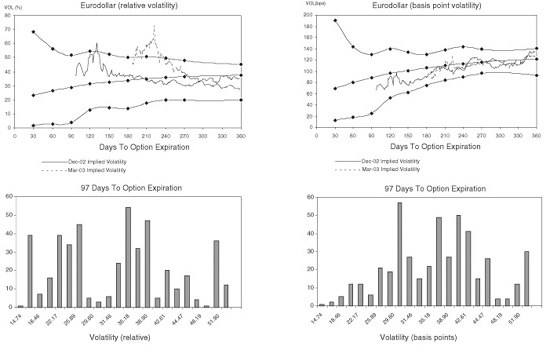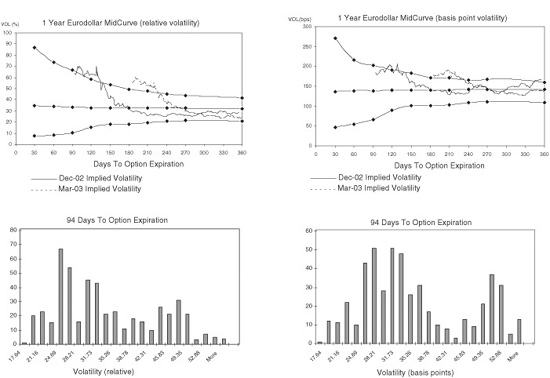 Chapter 26 Eurodollar Volatility: An Update
by Galen Burghardt
The Eurodollar Futures and Options Handbook
Chapter 26 Eurodollar Volatility: An Update
by Galen Burghardt
The Eurodollar Futures and Options Handbook
- Cover Page
- The Eurodollar Futures and Options Handbook
- Copyright Page
- Contents
- List of Exhibits
- List of Examples
- List of Equations
- List of Contributors
- Foreword
- Part One The Emergence of the Eurodollar Market
- Chapter 1 The Emergence of the Eurodollar Market
- Part Two Building Blocks: Eurodollar Futures
- Chapter 2 The Eurodollar Time Deposit
- Chapter 3 The Eurodollar Futures Contract
- Chapter 4 Forward and Futures Interest Rates
- Deriving a Forward Rate from Two Term Deposit Rates
- Locking an Effective Forward Lending Rate Using Eurodollar Futures
- Important Differences between Forward and Futures Markets
- Determining the Fair Value of a Eurodollar Futures Contract
- Richness and Cheapness
- Forward Rates Are Break-Even Rates
- Yield Curve Trades
- Finding the Forward Term Deposit Curve Implied by Today’s Futures Rates
- Chapter 5 Hedging with Eurodollar Futures
- Chapter 6 Pricing and Hedging a Swap with Eurodollar Futures
- Fixed/Floating Interest Rate Swaps
- Approaches to Pricing and Hedging Interest Rate Swaps
- Pricing a Swap Using the Cash Flow Method
- Hedging a Swap Using the Cash Flow Method
- Pricing a Swap Using the Hypothetical Securities Method
- Hedging a Swap Using the Hypothetical Securities Method
- Pricing and Hedging Off-the-Market Swaps
- Convexity Differences between Forward and Futures Rates
- Comparing Three Yield Curves: Forward, Zero Coupon, and Par Coupon
- Part Three Eurodollar Futures Applications
- Convexity Bias (Chapters 7 through 10)
- Term TED Spreads (Chapters 11 and 12)
- Hedging and Trading with Eurodollar Stacks, Packs, and Bundles (Chapter 13)
- Hedging Extension Risk in Callable Agency Notes (Chapter 14)
- Opportunities in the S&P Calendar Roll (Chapter 15)
- Trading the Turn (Chapters 16 and 17)
- Chapter 7 The Convexity Bias in Eurodollar Futures
- Galen Burghardt and William Hoskins Research note originally released September 16, 1994
- Synopsis
- Introduction
- Interest Rate Swaps and Eurodollar Futures
- How Much Is the Convexity Bias Worth?
- Reconciling the Difference between a Swap and a Eurodollar Futures Contract
- A Workable Rule of Thumb
- The Importance of the Bias for Pricing Term Swaps
- The Market’s Experience with the Convexity Bias
- Now What?
- APPENDIX A Deriving the Rule of Thumb
- APPENDIX B Calculating Eurodollar Strip Rates and Implied Swap Rates
- Chapter 8 Convexity Bias Report Card
- Chapter 9 New Convexity Bias Series
- Chapter 10 Convexity Bias: An Update
- Chapter 11 Measuring and Trading Term TED Spreads
- Galen Burghardt, William Hoskins, and Susan Kirshner Research note originally released July 26, 1995
- Synopsis
- TED Spreads
- Two Kinds of Term TED Spreads
- How Do These Rates Compare?
- How Directional Is the Spread?
- Trading the Spreads
- What to Do with the Stub
- Forward Term TED Spreads
- Term TED Spreads and Swap Spreads
- APPENDIX Complete Operating Instructions for Calculating Term TED Spreads and Hedge Ratios
- Chapter 12 TED Spreads: An Update
- Chapter 13 Hedging and Trading with Eurodollar Stacks, Packs, and Bundles
- Galen Burghardt, George Panos, and Fred Sturm Research note originally released December 15, 1999
- Synopsis
- Hedging and Trading with Eurodollar Stacks, Packs, and Bundles
- Basics: Dates, Names, Packs, Bundles, and Quotes
- Quote Practices 1: Ticks
- Quote Practices 2: Use Price Level for Individual Contracts
- Quote Practices 3: Use Price Changes for Packs and Bundles
- Unpacking Packs, Unbundling Bundles
- Hedging with Stacks, Packs, and Bundles
- Trading Curve TEDs
- Chapter 14 Hedging Extension and Compression Risk in Callable Agency Notes
- Galen Burghardt and William Hoskins Research note originally released March 24, 1995
- Synopsis
- Introduction
- Structuring a Hedge
- Example of Hedging a 10-Year, 8.5 Percent Coupon Note, Callable in 5 Years
- The Costs and Risks of Delta Hedging
- The Yield Spread between Agencies and Treasurys
- What If There Is Little or No Call Protection?
- Sometimes Strips of Eurodollar Futures Provide Better Hedges
- Chapter 15 Opportunities in the S&P 500 Calendar Roll
- Chapter 16 Trading the Turn: 1993
- Chapter 17 The Turn: An Update
- Convexity Bias (Chapters 7 through 10)
- Part Four Building Blocks: Eurodollar Options
- Chapter 18 The Eurodollar Option Contract
- Chapter 19 Price, Volatility, and Risk Parameter Conventions
- Chapter 20 Caps, Floors, and Eurodollar Options
- Chapter 21 Structure and Patterns of Eurodollar Rate Volatility
- Chapter 22 Practical Considerations
- Part Five Eurodollar Option Applications
- Trading with Serial and Mid-curve Eurodollar Options (Chapters 23 and 24)
- What Happens to Eurodollar Volatility when Rates Fall? (Chapters 25 and 26)
- Hedging Convexity Bias (Chapter 27)
- Chapter 23 Trading with Serial and Mid-curve Eurodollar Options
- Galen Burghardt and Scott Lyden Research note originally released June 22, 1998
- Synopsis
- The Full Constellation of Eurodollar Options
- The Beauty of This Design
- The Eurodollar Strategy Triangle
- Different Volatility Horizons
- Mid-curve Options versus OTC Treasury Options
- Some Things to Keep in Mind
- LIFFE’s Options
- Chapter 24 Serial and Mid-curve Options: An Update
- Chapter 25 What Happens to Eurodollar Volatility When Rates Fall?
- Chapter 26 Eurodollar Volatility: An Update
- Chapter 27 Hedging Convexity Bias
- Glossary
- Index
- About the Author
- Footnotes
CHAPTER 26
Eurodollar Volatility: An Update
One of the striking lessons we learned about Eurodollar rate volatility when Eurodollar rates dropped below 2 percent in 2002 was that basis point volatility did not seem to be related to the level of interest rates. This insight prompted us to augment our volatility cone report to include basis point volatility cones in addition to the usual relative rate volatility cones.
The sample volatility cone report shown in Exhibit 26.1, using closing data from September 10, 2002, shows how important the distinction can be. Notice, for example, that on a relative volatility basis (the top left panel), options on the Dec ′02 and Mar ′03 contracts went through a period of appearing to be extremely expensive. At one point, implied relative rate volatility for the Dec ′02 option reached 60 percent, while implied relative rate volatility for the Mar ′03 option traded at 70 percent. Both of these implied volatilities were higher than any historical relative rate volatility for comparable times to these options’ expirations over the previous 2 years. In basis point terms (see top right panel), however, both of these options appeared to be relatively inexpensive, trading in the lower end of the volatility cone. In fact, implied basis point volatility rose very slightly in the face of economic events of the time, but because interest rates had fallen so much, implied relative rate volatility rose dramatically.
EXHIBIT 26.1
Volatility Cones and Return Distributions 2-Year History as of September 10, 2002


In light of our findings about the comparative stability of basis point volatility, the basis point volatility cone would seem to be the more reliable measure of richness or cheapness.
-
No Comment